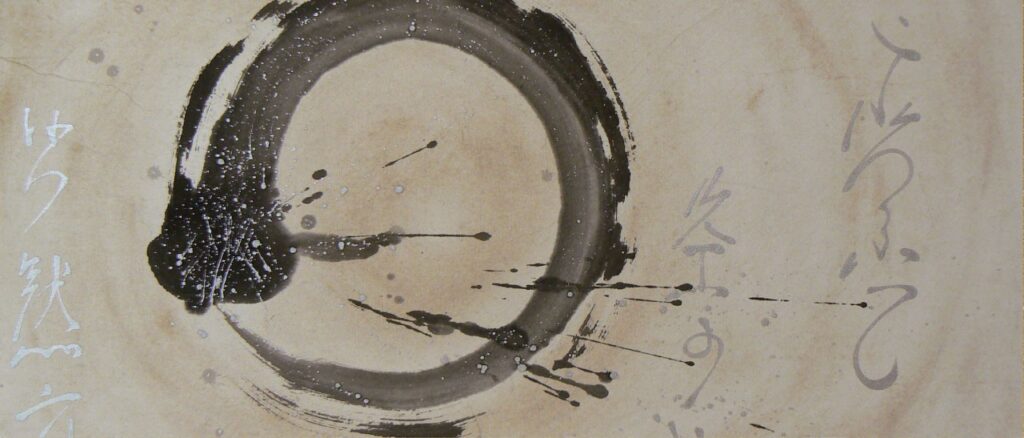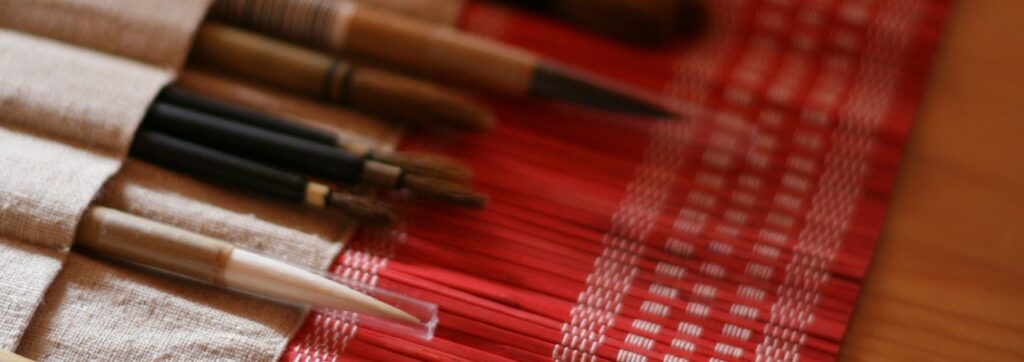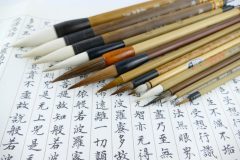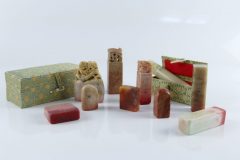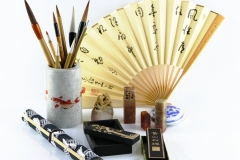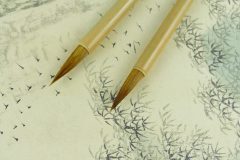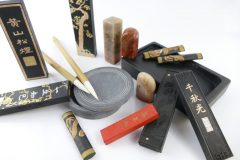WHAT IS SUMI-E ?
The real sumi-e
The Japanese term “sumi” means “black ink”, “e” means “painting”. It indicates one of the art forms in which subjects are painted with black ink in all possible gradations ranging pure black to the lightest shades achievable by dissolving ink in water. However, this does not mean that everything painted in this way deserves to be called sumi-e.
Real sumi-e must correspond to typical features, such as simplicity and spontaneity that directly strike the viewers’ sensibility. In order for a painting to be “alive”, all its components must be alive. This type of painting already includes the sketch; there is no need for preparation, as in traditional painting; any superfluous form or detail is left out.
This way of painting was introduced into Japan by Zen monks and it then became rapidly successful because in this painting-method, as in Zen practice, reality is expressed by reducing it to its pure, bare form. Touch-ups, additions and decorations do not enhance a work, but rather hide its true nature. Just as in cooking, if you add too many spices, you won’t get the real flavour of what you have made.
Just as in Zen few words are enough to express the meaning of many hours of meditation, in sumi-e, few marks of black ink painted with a brush on a simple sheet of white paper, can represent the most complex model. One must learn to capture the essence in order to get to the heart of reality as it is.
The Way of the Brush
Let’s see for example what happens when we want to paint bamboo with the sumi-e method: you sit down (but can also stand) with your back straight, you put a sheet of paper in front of you and concentrate on it, breathing calmly and naturally. You let all other thoughts fade until only a white sheet of paper remains in your mind. Next, you let the image to be painted appear to your mind. In order to paint the bamboo, you must feel its “consistency”, see its trunk, its branches, feel its light leaves stirred by a breeze or wind or wet, heavy with rain.
Your spirit is full of this and more; it becomes the bamboo, it is indescribable.
Then you pick-up the brush and let your hand move in a natural way, effortlessly.
There is no thought about technique or about the result, there is no conscious effort to make a nice painting. Little by little, your complete bamboo will take shape and you will have a painting that is unquestionably alive. The bamboo is “created” from nothing, not just copied.
On rice paper, only one brush stroke is allowed for each mark: any touch-ups are immediately evident. All mental activities that are complicating the image (and your life) are given-up. So you understand that your thoughts about life, are not life itself and your thoughts about Zen, are not Zen; they are just thought…
How to learn
This way of painting is complete, it involves your whole body. It is not easy at all and working with an expert teacher is necessary, as well as getting used to repeating subjects, or parts of them, an innumerable number of times. The spirit becomes more and more refined and sensitive through constant repetition.
At the start, it is inevitable that your paintings will be cold and unnatural. Eventually, you may wish to have more beauty in your work, although this shouldn’t turn into an obsession of wanting to become a perfect practitioner of sumi-e, since then, by doing so, you wouldn’t make any progress. If you go on thinking in terms of good and bad, you are still far from the true spirit of sumi-e.
As in Zen, the spirit must be free from any voluntary desire for success and ambition. Probably, much sooner than you think, you will feel able to paint whatever you wish, because every part of a landscape will appear as the true reflection of the source of life and nature.
You will also realise that you are breathing better, that your body posture is more upright and “nobler” and that your overall health has also improved, including your spiritual psychological equilibrium.
In Zen, zazen is not just about learning a “meditation technique” but rather, it is about establishing a direct contact with the origin of everything (“Buddha nature”). In the same way, sumi-e goes beyond a simple “painting technique”.
MATERIALS
RICE PAPER
Rice paper is found in various varieties of thickness, consistency, absorption, texture, etc. To get started, we suggest using one with the least absorbency and of average size (24.5 cm x33 cm).
BRUSHES
Brushes are all made of natural bristle (horse, badger, goat, ox, weasel, etc.). They vary in shape, size, length and bristle type. Generally, they can be classified according to brush length, as large, medium or small, and according to bristle length, as long, medium or short. For beginners, it is advisable to use brushes that have a mixture of both soft and stiff bristles. They are the easiest to use and hold the ink well (average bristle length: 4.5 – 5.5 cm). When you’ve finished painting, you need to wash the brush at once with cold water, dry it and hang it up in a dry place.
CHINA (BLACK) INK
China ink comes in bars made of soot from natural pine resin or rape-seed oil mixed with glue extracted from hide. The China ink bars are dissolved with water while rubbing them on a special stone known as a SUZURI.
INK STONE (SUZURI)
It is usually rectangular, includes surfaces on which SUMI ink is rubbed, and has a small area which holds water. To prepare the ink, you fill this area approximately two thirds full with water, then you dip the bar, bringing a little water along with it to the surface of the stone and start rubbing with a circular movement; the movement has to be clean, constant and vigorous, without exerting excessive pressure.

